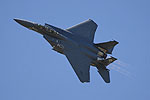Report: Crew error led to F-15E crash
 High above Afghanistan, in the dark, Capt. Mark R. McDowell pointed the nose of his F-15E Strike Eagle at a practice target on the ground. He thought the dry lake bed was 4,800 feet above sea level. It was 10,200 feet high.
High above Afghanistan, in the dark, Capt. Mark R. McDowell pointed the nose of his F-15E Strike Eagle at a practice target on the ground. He thought the dry lake bed was 4,800 feet above sea level. It was 10,200 feet high.
The F-15E went into a 31-degree dive going 515 mph. The jet’s ground collision alarm snapped on, lighting up display screens with arrows pointing up and a computer voice warning four times to “pull up.”
McDowell and Capt. Thomas J. Gramith, his weapons systems officer, didn’t react. Three seconds after the alarm came on, the jet crashed, killing both airmen. They didn’t try to eject.
The Air Combat Command accident investigation board is attributing the July 18 crash, the first fighter-jet crash in Afghanistan since the war started, to aircrew mistakes.
“It was a tragic, human error,” Brig. Gen. Harry D. Polumbo, the lead investigator, told reporters in a conference call.
McDowell and Gramith, both deployed to Bagram Air Field from the 4th Fighter Wing, Seymour Johnson Air Force Base, N.C., were in the second jet of a two-jet formation that had spent almost four hours flying on-call close-air support. As the uneventful sortie neared its end, the fighters received permission to practice what Polumbo described as one of the “most difficult and challenging things that an aircrew member does” — a high-angle strafing run at night with the officers wearing night-vision goggles.
The airmen had used the lake bed, about 30 miles west of the town of Ghazni, as a training target before.
The first F-15E, flown by pilot Capt. Kenneth Fryar and weapons systems officer Capt. Benjamin Hopkins, led the way to the lake bed. About 10 minutes before reaching the practice target, Hopkins checked its altitude using a digital map. The computer display read 4,800 feet high and Hopkins relayed the information to McDowell and Gramith.
As the Strike Eagles flew over the lake bed, none of the four airmen realized their jets’ radar altimeters and laser rangefinders showed the lake bed was 10,200 feet high, Polumbo said.
The lead F-15E made the first run but aborted the attack because the dive was not steep enough. The second F-15E, the one flown by McDowell, started its dive 22 seconds later. And crashed.
Fryar and Hopkins have continued to fly and neither faced disciplinary action, Polumbo said.
Air Combat Command is reviewing pre-deployment night strafing training.
The four airmen were all considered “experienced,” but McDowell and Gramith had limited practice flying night strafing runs.
A similar crash June 22 claimed the life of an F-16 pilot in a training mission over Utah.